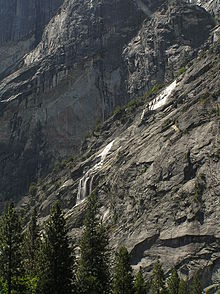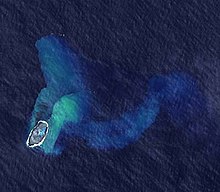Ephemerality: Difference between revisions
Plastikspork (talk | contribs) Script-assisted whitespace removal, table & color simplification, and link repair. |
No edit summary |
||
| Line 15: | Line 15: | ||
[[Lake Carnegie (Western Australia)|Lake Carnegie]] in [[Western Australia]] and [[Lake Cowal]] in [[New South Wales]] are ephemeral lakes. Lake Tuzkan and [[Mystic Lake (California)|Mystic Lake]] in California are ephemeral. |
[[Lake Carnegie (Western Australia)|Lake Carnegie]] in [[Western Australia]] and [[Lake Cowal]] in [[New South Wales]] are ephemeral lakes. Lake Tuzkan and [[Mystic Lake (California)|Mystic Lake]] in California are ephemeral. |
||
There are also ephemeral islands such as [[Banua Wuhu]] and [[Home Reef]] |
There are also ephemeral islands such as [[Banua Wuhu]] and [[Home Reef]]. These islands appear when volcanic activity increases their height above sea level, but disappear over the course of several years due to wave erosion. [[Bassas da India]], on the other hand, is a near-sea level island that appears only at low tide. |
||
==Biological examples== |
==Biological examples== |
||
Revision as of 21:52, 21 March 2009
It has been suggested that Ephemeral (disambiguation) and Talk:Ephemeral#Structure of the article be merged into this article. (Discuss) Proposed since December 2008. |



Ephemeral things (from Greek εφήμερος - ephemeros, literally "lasting only one day"[1]) are transitory, existing only briefly. Typically the term is used to describe objects found in nature, although it can describe a wide range of things.
Geographical examples
An ephemeral waterbody is a wetland, spring, stream, river, pond or lake that only exists for a short period following precipitation or snowmelt. They are not the same as intermittent or seasonal waterbodies, which exist for longer periods, but not all year round.
Examples of ephemeral streams are the Luni river in Rajasthan, India, Ugab River in Southern Africa, and a number of small ephemeral watercourses that drain Talak in northern Niger. Other notable ephemeral rivers include the Todd River and Sandover River in Central Australia as well as the Son River, Batha River and the Trabancos River.
Lake Carnegie in Western Australia and Lake Cowal in New South Wales are ephemeral lakes. Lake Tuzkan and Mystic Lake in California are ephemeral.
There are also ephemeral islands such as Banua Wuhu and Home Reef. These islands appear when volcanic activity increases their height above sea level, but disappear over the course of several years due to wave erosion. Bassas da India, on the other hand, is a near-sea level island that appears only at low tide.
Biological examples
Many plants are adapted to an ephemeral lifestyle, in which they spend most of the year or longer as seeds before conditions are right for a brief period of growth and reproduction. The spring ephemeral plant mouse-ear cress is a well known example. Animals can be ephemeral, with brine shrimp being an example.
Ephemeral artifacts
Ephemeral can also be used as an adjective to refer to a fast-deteriorating importance or temporary nature of an object to a person. Brands are notoriously ephemeral assets, and magazine publishing was once much more ephemeral than it is today.
A number of art forms can be considered ephemeral because of their temporary nature. Early land art and all sand sculptures, ice sculptures and chalk drawings on footpaths are examples of ephemeral art. G. Augustine Lynas and Duthain Dealbh create ephemeral sculptures.
Other uses
The placenta is considered an ephemeral organ present during gestation and pregnancy.
A sensation which is felt by a person for a certain period of time before needing replenishment can be referred to as ephemeral. Often, happiness is described as ephemeral, as one does not find it as a permanent state, with human lives always varying shades of happiness and disappointment.
In computer networking technology, an Ephemeral port is a TCP, UDP or SCTP port which is dynamically assigned to a client application for a short period of time (the duration of time the application is running). This is in contrast to the "Well known" ports which are typically statically assigned to a specific application or service.
Further reading
- Christine Buci-Glucksmann, Esthetique De L'ephemere, Galilee, ISBN 2718606223
